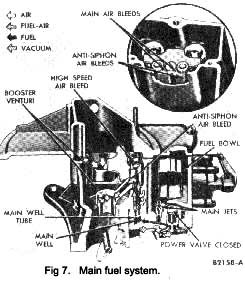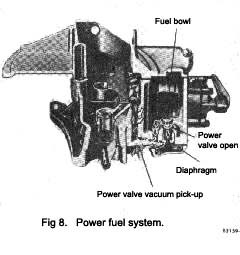
When the throttle is opened, the diaphragm rod is forced inward, forcing fuel from the chamber into the discharge passage. Fuel under pressure forces the pump discharge weight and bail off their seat and fuel passes through the accelerating pump discharge screw and is sprayed into each main venturi through discharge ports. An air bleed in the wall of the accelerating pump fuel chamber allows any vapour to escape. This prevents pressure build-up in the diaphragm chamber.
An accelerating pump cavity filler, located in the ac-celerating pump fuel chamber, decreases the volume of the accelerating pump cavity. The filler improves the rate of fuel delivery, and prevents engine stumble and hesitation on acceleration.
Main fuel system
As engine speed increases, the air passing through the booster venturi creates a vacuum. The amount of vacuum is determined by the air flow through the venturI, which in turn is regulated by the speed of the engine. The difference in pressure between the main discharge port and the fuel bowl causes fuel to flow through the main fuel system (Fig. 7).
At a predetermined venturi vacuum, fuel flows from the fuel bowl, through the main jets, and into the bottom of the main well. The fuel moves up the main well tube past air bleed holes. Filtered air from the high speed air bleed enters the fuel flow in the main well tube through holes in the side of the tube. The high speed air bleed meters an Increasing amount of air to the fuel as venturi vacuum
|
increases, maintaining the required fuel-air ratio. The mixture of fuel and air is lighter than raw fuel and res-ponds faster to changes in venturi vacuum. It also vaporizes more readily than raw fuel. The fuel and air continue up the main well tube past another air bleed which also acts as a vent to prevent siphoning when the engine is shut down. The fuel is discharged into the booster venturi where it is vaporized and mixed with the air flowing through the carburettor.
The throttle plate controls the amount of the fuel-air mixture admitted to the intake manifold, regulating the speed and power output of the engine.
A balance tube is located in each barrel directly below the booster venturi. When decelerating, the balance tube siphons off any excess fuel droplets remaining around the edge of the booster venturi and discharges the droplets into the equalizing slots in the base of the carburettor where they are mixed with the idle fuel. The balance tube also acts as an additional air bleed during the idle fuel system operation.
Power fuel system
During periods of increased road loads or high speed operation, the fuel-air ratio must be increased for added power. The added fuel required during this period is supplied by the power fuel system (Fig. 8).
The power fuel system is controlled by the manifold vacuum.
Manifold vacuum is transmitted from an opening in the base of the main body, through a passage in the main body and power valve chamber to the power valve diaphragm. The manifold vacuum, acting on the power valve at idle

|
 **
**

